小学三年级英语下册第十单元教案
- 格式:doc
- 大小:35.00 KB
- 文档页数:6
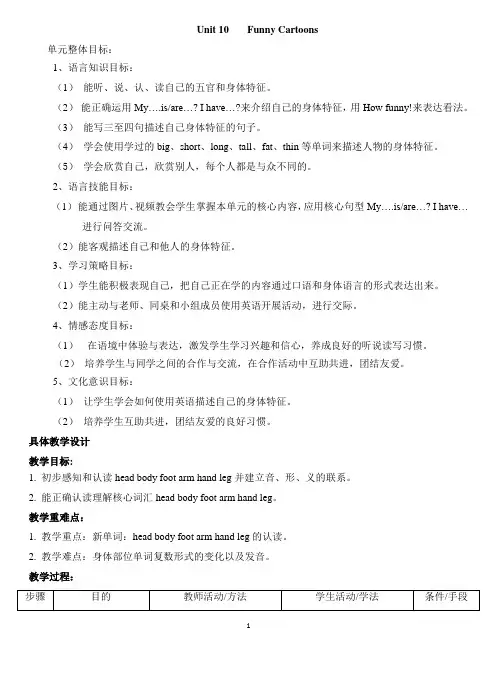
Unit 10 Funny Cartoons单元整体目标:1、语言知识目标:(1)能听、说、认、读自己的五官和身体特征。
(2)能正确运用My….is/are…? I have…?来介绍自己的身体特征,用How funny!来表达看法。
(3)能写三至四句描述自己身体特征的句子。
(4)学会使用学过的big、short、long、tall、fat、thin等单词来描述人物的身体特征。
(5)学会欣赏自己,欣赏别人,每个人都是与众不同的。
2、语言技能目标:(1)能通过图片、视频教会学生掌握本单元的核心内容,应用核心句型My….is/are…? I have…进行问答交流。
(2)能客观描述自己和他人的身体特征。
3、学习策略目标:(1)学生能积极表现自己,把自己正在学的内容通过口语和身体语言的形式表达出来。
(2)能主动与老师、同桌和小组成员使用英语开展活动,进行交际。
4、情感态度目标:(1)在语境中体验与表达,激发学生学习兴趣和信心,养成良好的听说读写习惯。
(2)培养学生与同学之间的合作与交流,在合作活动中互助共进,团结友爱。
5、文化意识目标:(1)让学生学会如何使用英语描述自己的身体特征。
(2)培养学生互助共进,团结友爱的良好习惯。
具体教学设计教学目标:1. 初步感知和认读head body foot arm hand leg并建立音、形、义的联系。
2. 能正确认读理解核心词汇head body foot arm hand leg。
教学重难点:1. 教学重点:新单词:head body foot arm hand leg的认读。
2. 教学难点:身体部位单词复数形式的变化以及发音。
教学过程:板书设计:教学后记:经过本课时的学习,孩子们能对教学内容文本朗朗上口,,能自由谈论自己身体的部位。
我认为本节课基本完成了所设置的教学任务以及解决了教学的重难点。
本节课的一些亮点:1.以旧带新,分层次设置任务:作为本单元的第一课时,本课时通过复习旧句型引出本课时教学内容,既起到了复习效果,又降低了新知的难度,强调了整个单元的完整性。
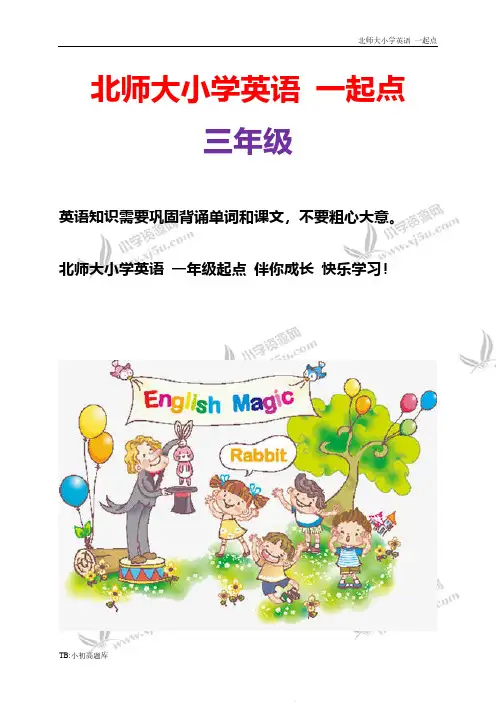
北师大小学英语一起点三年级英语知识需要巩固背诵单词和课文,不要粗心大意。
北师大小学英语一年级起点伴你成长快乐学习!(北师大版)英语教案三年级下册Unit10Unit 10 Mocky's StoreThe second period一、教学目标:1. 熟悉本单元新词汇comic,farm,sheep,cow。
2. 会使用What’s this?It’s…会话。
3. 会说What does…have? He has…句型。
二、教学重点和难点:重点:能在情景中运用What’s this?It’s…。
难点:运用What does…have? He has…句型。
三、教具准备: 本单元的教学卡片 camera的教学卡片四、教学步骤Step 1 用卡片复习本单元的词汇。
拿起一张卡片,问:“What’s this?”引导学生回答:“It’s a (comic).” 用同样的方法练习其余的卡片。
Step 2 放录音,让学生指40页对应的图。
再放一遍录音,每次放一个单词,让学生跟读。
再放一遍录音,不停顿。
让学生跟读。
不放录音,指其中一幅图引导学生说出正确的单词。
用同样的方法完成其余的图。
Step 3 提问“What does Mocky have?”让学生重复问题。
呈现句型“He has a (purse,comic).”把问题和回答写在黑板上。
指着每个单词朗读句子。
告诉学生每听到一句录音,就要找到40页相应的图。
放第一句录音。
让学生根据听到的录音指出对应的图。
用同样的方法完成其余的句子。
再放一遍录音,每次一句。
让学生把句子的序号写在相应的方框内。
全班一起核查结果(“What does Mocky have?”“He has a comic.”)。
Step 4 告诉他们接下来学一首关于动物及其叫声的歌曲,这首歌曲的名称叫Old MacDonald。
给学生解释Old MacDonald是一个老农夫的名字,他养了很多动物。
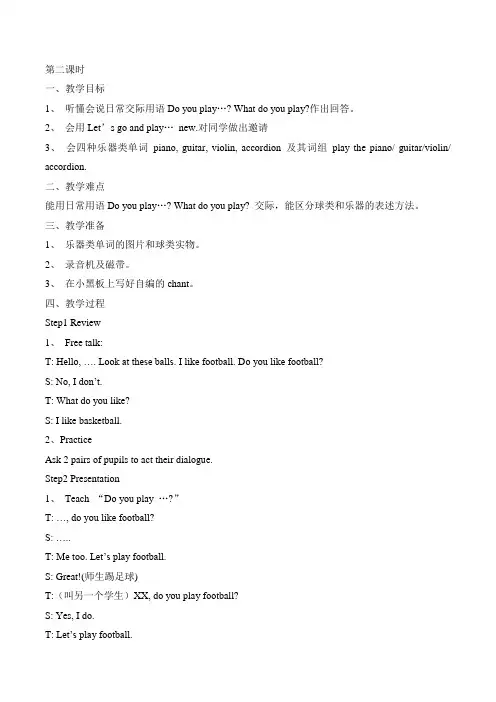
第二课时一、教学目标1、听懂会说日常交际用语Do you play…? What do you play?作出回答。
2、会用Let’s go and play…new.对同学做出邀请3、会四种乐器类单词piano, guitar, violin, accordion 及其词组play the piano/ guitar/violin/ accordion.二、教学难点能用日常用语Do you play…? What do you play? 交际,能区分球类和乐器的表述方法。
三、教学准备1、乐器类单词的图片和球类实物。
2、录音机及磁带。
3、在小黑板上写好自编的chant。
四、教学过程Step1 Review1、Free talk:T: Hello, …. Look at these balls. I like football. Do you like football?S: No, I don’t.T: What do you like?S: I like basketball.2、PracticeAsk 2 pairs of pupils to act their dialogue.Step2 Presentation1、Teach “Do you play …?”T: …, do you like football?S: …..T: Me too. Let’s play football.S: Great!(师生踢足球)T:(叫另一个学生)XX, do you play football?S: Yes, I do.T: Let’s play football.S: OK. (师生踢足球)Chant: Do you, do you, do you play football?Yes, yes, yes, I do.Do you, do you, do you play baseball?No, no, no, I don’t.(学生换词自编)2、Teach “What do you play?”T: You are all very good. Now please look at me. Guess what do I play? S: Play football/…T: Yes, you’re rig ht. I play football. What do you play?S1: I play basketball.Teacher asks 3/4 students “What do you play?”Ask and answer in pairs.Do you play…?What do you play? …..教乐器类单词和词组3. Teach “piano”---“play the piano”T: (Point at the picture) Look, it’s a piano. Is this piano nice?: Yes, it is.T: Now look, what do I play?…………….T: Piano, piano, I play the piano.出示词组: play the pianoMake a dialogue.Model: T: Do you play the piano?S: Yes, I do.T: Let’s go and play the piano.S: Good, let’s g o.Work in pairs and then actT: What’s this in my hand? (A picture of a violin)S: I don’t know. What’s this, Miss Zhang?T: It’s a violin.Teach “violin”---“play the violin”同法教学“play the guitar / accordion.”,注意“an accordion”的连读。
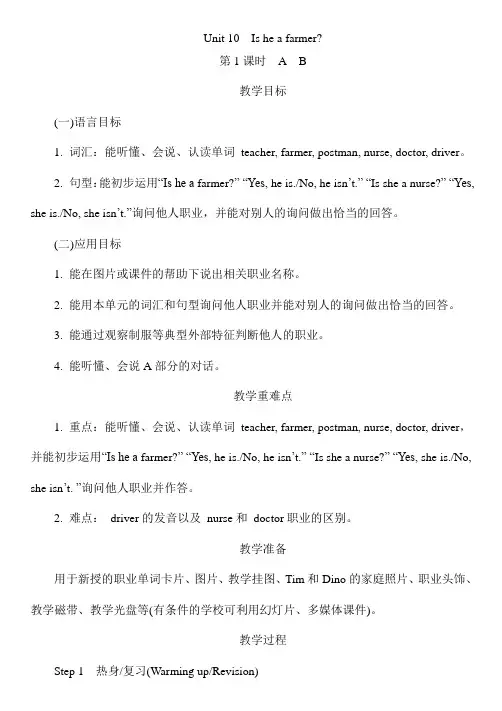
Unit 10Is he a farmer?第1课时A B教学目标(一)语言目标1. 词汇:能听懂、会说、认读单词teacher, farmer, postman, nurse, doctor, driver。
2. 句型:能初步运用“Is he a farmer?”“Yes, he is./No, he isn’t.”“Is she a nurse?”“Yes, she is./No, she isn’t.”询问他人职业,并能对别人的询问做出恰当的回答。
(二)应用目标1. 能在图片或课件的帮助下说出相关职业名称。
2. 能用本单元的词汇和句型询问他人职业并能对别人的询问做出恰当的回答。
3. 能通过观察制服等典型外部特征判断他人的职业。
4. 能听懂、会说A部分的对话。
教学重难点1. 重点:能听懂、会说、认读单词teacher, farmer, postman, nurse, doctor, driver,并能初步运用“Is he a farmer?”“Yes, he is./No, he isn’t.”“Is she a nurse?”“Yes, she is./No, she isn’t. ”询问他人职业并作答。
2. 难点:driver的发音以及nurse和doctor职业的区别。
教学准备用于新授的职业单词卡片、图片、教学挂图、Tim和Dino的家庭照片、职业头饰、教学磁带、教学光盘等(有条件的学校可利用幻灯片、多媒体课件)。
教学过程Step 1热身/复习(Warming up/Revision)1. A chant: Who’s she?Who’s she? Is she your sister?Uh-huh, yes, she is my sister.Who’s she? Is she your mother?Uh-huh, no, she isn’t my mother.Who’s he? Is he your brother?Uh-huh, yes, he is my brother.Who’s he? Is he your father?Uh-huh, no, he isn’t my father....2. Free talk.T: Hello, boys and girls. What do you like?S: I like a sunny day.T: What do you like?S: I like a dog.T: And what do you like?S: I like an apple.T: What do I like? Do you want to know? Ask me, please.S: What do you like, Miss Qin?T: I like you. I like all of you because you are my students. (既复习旧知,又自然导入新授)Step 2新课呈现(Presentation)1. New words.(1)教授单词nurse, doctor, driver, farmer, postman, teacher。
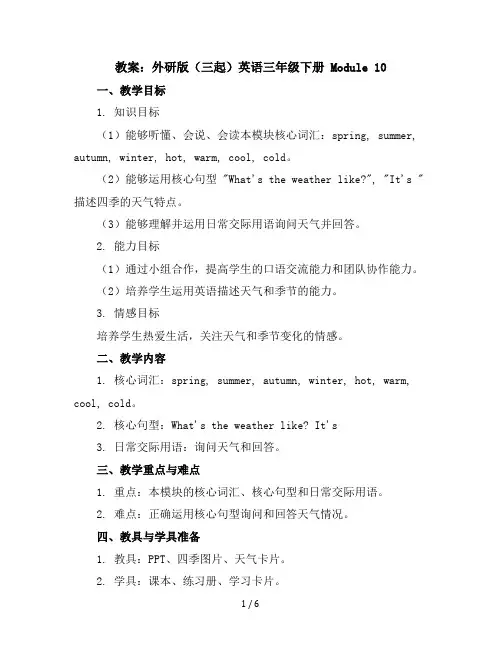
教案:外研版(三起)英语三年级下册 Module 10一、教学目标1. 知识目标(1)能够听懂、会说、会读本模块核心词汇:spring, summer, autumn, winter, hot, warm, cool, cold。
(2)能够运用核心句型 "What's the weather like?", "It's " 描述四季的天气特点。
(3)能够理解并运用日常交际用语询问天气并回答。
2. 能力目标(1)通过小组合作,提高学生的口语交流能力和团队协作能力。
(2)培养学生运用英语描述天气和季节的能力。
3. 情感目标培养学生热爱生活,关注天气和季节变化的情感。
二、教学内容1. 核心词汇:spring, summer, autumn, winter, hot, warm, cool, cold。
2. 核心句型:What's the weather like? It's3. 日常交际用语:询问天气和回答。
三、教学重点与难点1. 重点:本模块的核心词汇、核心句型和日常交际用语。
2. 难点:正确运用核心句型询问和回答天气情况。
四、教具与学具准备1. 教具:PPT、四季图片、天气卡片。
2. 学具:课本、练习册、学习卡片。
五、教学过程1. 热身(5分钟)(1)教师与学生用英语进行日常交流,询问学生身体状况和当天的心情。
(2)学生进行小组活动,用英语介绍自己的季节喜好。
2. 导入(10分钟)(1)教师通过PPT展示四季的图片,引导学生用英语描述季节特点。
(2)学生听录音,模仿四季的语音语调。
3. 新课呈现(15分钟)(1)教师通过PPT展示核心词汇和核心句型,引导学生跟读和学习。
(2)学生进行小组活动,用核心句型询问并回答天气情况。
4. 课堂练习(10分钟)(1)学生进行课本练习,巩固所学知识。
(2)教师提供天气卡片,学生用英语描述卡片上的天气情况。
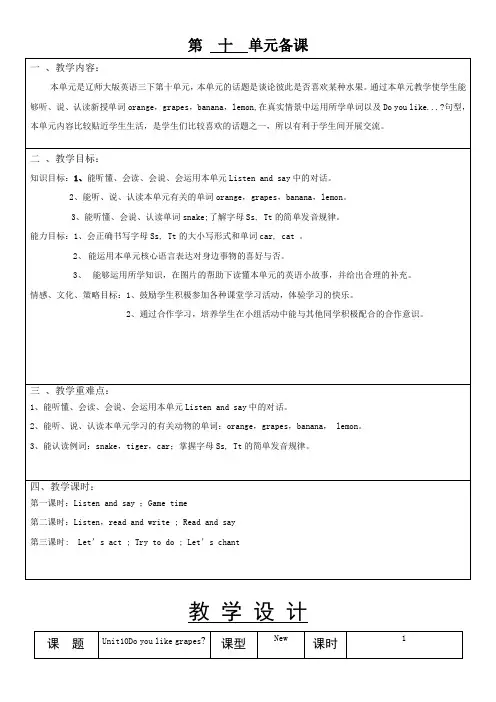
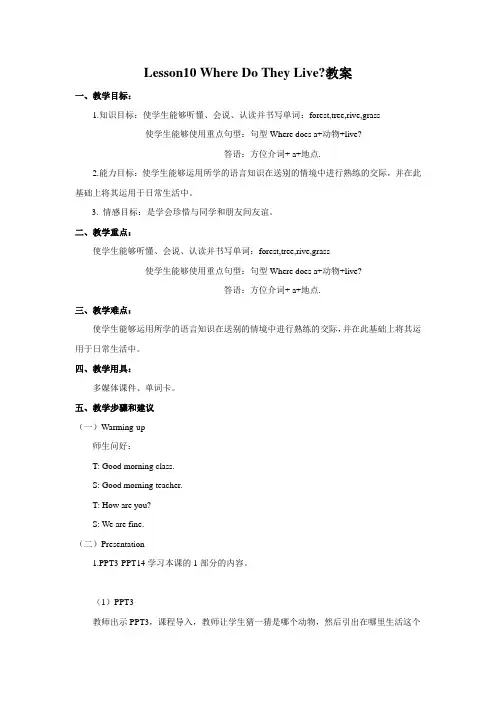
Lesson10 Where Do They Live?教案一、教学目标:1.知识目标:使学生能够听懂、会说、认读并书写单词:forest,tree,rive,grass使学生能够使用重点句型:句型Where does a+动物+live?答语:方位介词+ a+地点.2.能力目标:使学生能够运用所学的语言知识在送别的情境中进行熟练的交际,并在此基础上将其运用于日常生活中。
3. 情感目标:是学会珍惜与同学和朋友间友谊。
二、教学重点:使学生能够听懂、会说、认读并书写单词:forest,tree,rive,grass使学生能够使用重点句型:句型Where does a+动物+live?答语:方位介词+ a+地点.三、教学难点:使学生能够运用所学的语言知识在送别的情境中进行熟练的交际,并在此基础上将其运用于日常生活中。
四、教学用具:多媒体课件、单词卡。
五、教学步骤和建议(一)Warming-up师生问好:T: Good morning class.S: Good morning teacher.T: How are you?S: We are fine.(二)Presentation1.PPT3-PPT14学习本课的1部分的内容。
(1)PPT3教师出示PPT3,课程导入,教师让学生猜一猜是哪个动物,然后引出在哪里生活这个问题。
(2)PPT4教师出示PPT4,教师提问学生What’s this,学习新单词。
(3)PPT5教师出示PPT5,教师讲解各个动物在哪生活,并划出重点。
(4)PPT6教师出示PPT6,教师讲解句型Where does a+动物+live?句型结构:Where does a+动物+live?用法:用于询问某个动物生活在哪里。
答语:方位介词+ a+地点.例句:—Where does a monkey live? 猴子生活在哪?—In a tree. 在树上。
(5)PPT7教师出示PPT7,教师易错讲解。
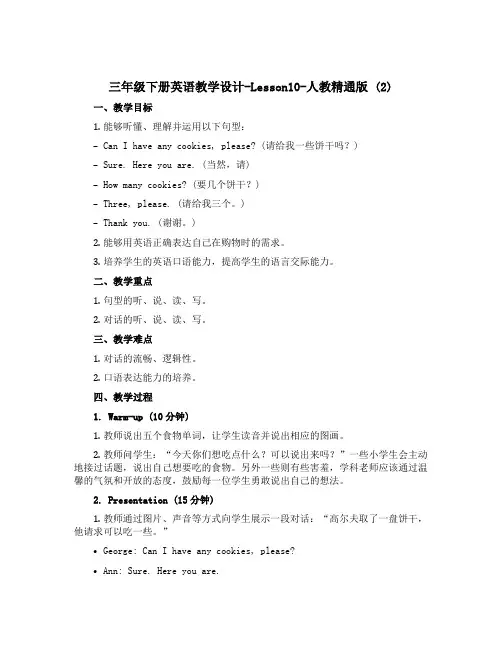
三年级下册英语教学设计-Lesson10-人教精通版 (2)一、教学目标1.能够听懂、理解并运用以下句型:–Can I have any cookies, please? (请给我一些饼干吗?)–Sure. Here you are. (当然,请)–How many cookies? (要几个饼干?)–Three, please. (请给我三个。
)–Thank you. (谢谢。
)2.能够用英语正确表达自己在购物时的需求。
3.培养学生的英语口语能力,提高学生的语言交际能力。
二、教学重点1.句型的听、说、读、写。
2.对话的听、说、读、写。
三、教学难点1.对话的流畅、逻辑性。
2.口语表达能力的培养。
四、教学过程1. Warm-up (10分钟)1.教师说出五个食物单词,让学生读音并说出相应的图画。
2.教师问学生:“今天你们想吃点什么?可以说出来吗?”一些小学生会主动地接过话题,说出自己想要吃的食物。
另外一些则有些害羞,学科老师应该通过温馨的气氛和开放的态度,鼓励每一位学生勇敢说出自己的想法。
2. Presentation (15分钟)1.教师通过图片、声音等方式向学生展示一段对话:“高尔夫取了一盘饼干,他请求可以吃一些。
”•George: Can I have any cookies, please?•Ann: Sure. Here you are.2.然后,教师向学生展示另一张饼干的图片,问道:“George问了Ann ‘CanI have any cookies, please?’。
Ann用了什么回答呢?思考一下。
接着老师为学生展示答案’Sure. Here you are.’。
”教师可以指着图画上的文本,来帮助学生更好地理解对话的内容。
3.教师再通过对话的方式向学生介绍“要几个饼干?”、“请给我三个”,“谢谢”等常用语,并鼓励学生跟着老师说一遍。
3. Practice (20分钟)1.教师将学生分为两人一组,分角色一人扮演买家一人扮演卖家进行对话练习。
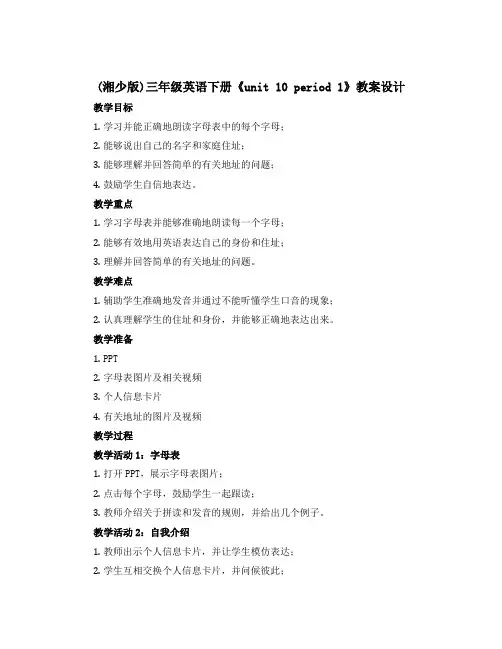
(湘少版)三年级英语下册《unit 10 period 1》教案设计教学目标1.学习并能正确地朗读字母表中的每个字母;2.能够说出自己的名字和家庭住址;3.能够理解并回答简单的有关地址的问题;4.鼓励学生自信地表达。
教学重点1.学习字母表并能够准确地朗读每一个字母;2.能够有效地用英语表达自己的身份和住址;3.理解并回答简单的有关地址的问题。
教学难点1.辅助学生准确地发音并通过不能听懂学生口音的现象;2.认真理解学生的住址和身份,并能够正确地表达出来。
教学准备1.PPT2.字母表图片及相关视频3.个人信息卡片4.有关地址的图片及视频教学过程教学活动1:字母表1.打开PPT,展示字母表图片;2.点击每个字母,鼓励学生一起跟读;3.教师介绍关于拼读和发音的规则,并给出几个例子。
教学活动2:自我介绍1.教师出示个人信息卡片,并让学生模仿表达;2.学生互相交换个人信息卡片,并问候彼此;3.接着让几名学生背诵和展示他们的卡片上的信息。
教学活动3: 有关地址的问题1.展示图片和视频,鼓励学生回答相应的简单问题;2.介绍有关地址和位置的词汇;3.学生互相练习问答。
教学活动4: 拓展练习1.学生在卡片上写下他们的英文名字和家庭住址,并和同桌分享;2.学生表演交通手势和方位;3.教师选择几个学生分享它们在社区中的位置。
教学反思这节课的教学重点是通过学习字母表和自我介绍引导学生理解和表达有关地址的问题。
一开始,孩子们对字母表的发音很感兴趣,但有些学生的口音让他们难以听懂。
在教学过程中,老师不仅要注意每个学生的发音,还要做好教学规则和拼读技巧的解释,并不断鼓励学生。
同时,老师还介绍了有关地址和位置的词汇,这些词汇不仅在英语课上有用,在日常生活中也很常见。
在教学活动4中,让学生写下自己的英文名字和家庭住址激发了他们练习自我介绍的兴趣。
通过这节课的教学,孩子们不仅学习到了英文词汇和语法规则,更重要的是提高了自信和表达能力。
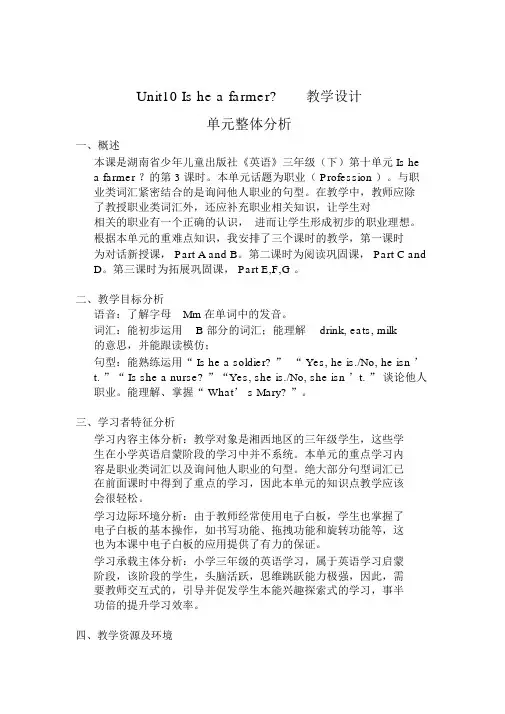
Unit10 Is he a farmer?教学设计单元整体分析一、概述本课是湖南省少年儿童出版社《英语》三年级(下)第十单元 Is hea farmer ?的第 3 课时。
本单元话题为职业( Profession )。
与职业类词汇紧密结合的是询问他人职业的句型。
在教学中,教师应除了教授职业类词汇外,还应补充职业相关知识,让学生对相关的职业有一个正确的认识,进而让学生形成初步的职业理想。
根据本单元的重难点知识,我安排了三个课时的教学,第一课时为对话新授课, Part A and B。
第二课时为阅读巩固课, Part C and D。
第三课时为拓展巩固课, Part E,F,G 。
二、教学目标分析语音:了解字母Mm在单词中的发音。
词汇:能初步运用 B 部分的词汇;能理解drink, eats, milk的意思,并能跟读模仿;句型:能熟练运用“ Is he a soldier? ” “ Yes, he is./No, he isn ’t. ”“ Is she a nurse? ”“Yes, she is./No, she isn ’t. ”谈论他人职业。
能理解、掌握“ What’ s Mary? ”。
三、学习者特征分析学习内容主体分析:教学对象是湘西地区的三年级学生,这些学生在小学英语启蒙阶段的学习中并不系统。
本单元的重点学习内容是职业类词汇以及询问他人职业的句型。
绝大部分句型词汇已在前面课时中得到了重点的学习,因此本单元的知识点教学应该会很轻松。
学习边际环境分析:由于教师经常使用电子白板,学生也掌握了电子白板的基本操作,如书写功能、拖拽功能和旋转功能等,这也为本课中电子白板的应用提供了有力的保证。
学习承载主体分析:小学三年级的英语学习,属于英语学习启蒙阶段,该阶段的学生,头脑活跃,思维跳跃能力极强,因此,需要教师交互式的,引导并促发学生本能兴趣探索式的学习,事半功倍的提升学习效率。
四、教学资源及环境PPT课件,电子白板及设备。
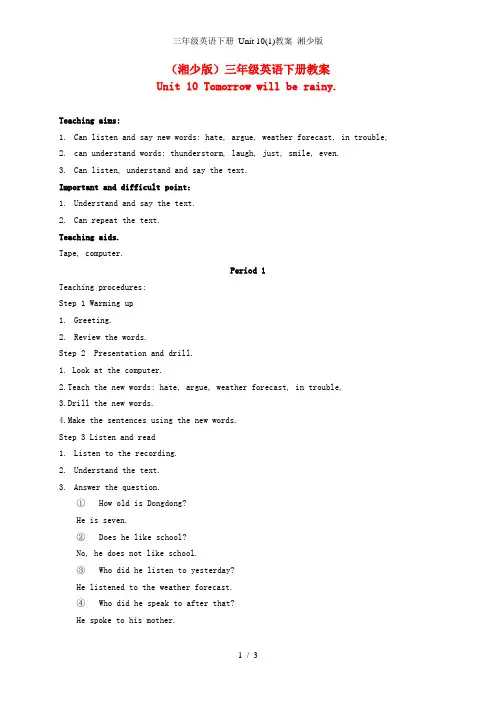
(湘少版)三年级英语下册教案Unit 10 Tomorrow will be rainy.Teaching aims:1.Can listen and say new words: hate, argue, weather forecast, in trouble,2.can understand words: thunderstorm, laugh, just, smile, even.3.Can listen, understand and say the text.Important and difficult point:1.Understand and say the text.2.Can repeat the text.Teaching aids.Tape, computer.Period 1Teaching procedures:Step 1 Warming up1.Greeting.2.Review the words.Step 2 Presentation and drill.1. Look at the computer.2.Teach the new words: hate, argue, weather forecast, in trouble,3.Drill the new words.4.Make the sentences using the new words.Step 3 Listen and read1.Listen to the recording.2.Understand the text.3.Answer the question.①How old is Dongdong?He is seven.②Does he like school?No, he does not like school.③Who did he listen to yesterday?He listened to the weather forecast.④Who did he speak to after that?He spoke to his mother.⑤Will there be heavy rain tomorrow?No, there will be light rain and strong winds.⑥How will Dongdong go to school tomorrow?He will go to school by bus.4.Important sentences pattern: tomorrow will be…5.Read after the tape sentence by sentence.6.Read in group.HomeworkListen and read.Write the new words.Period 2Teaching procedures:Step 1Warming up1.Greeting.2.Review.T: What day is today?S: It’s …T: How is the weather today?S: It’s rainy. / cloudy/windy/ sunny/hot/Step2.Part D1.Listen to the recording, read after the tape.2.Write the day in the boxes. Write a sentence about the weather. Keys: ①Sunday It will be a windy day.②Tuesday It will be a fine day.③Monday It will be a rainy day.④Friday It will be a cloudy day.⑤Wednesday There will be a typhoon.3.Read the keys.Step4.Part E1.Draw the weather for each day of the week.2.Write a sentence about it.HomeworkListen and read.Copy the text.Period 3Teaching procedures:Step1 Greetings:Step 2 part F.1.Discuss and try to guess the weather for each of the week.2.Write the guess in the box.Step 3 Exercise.Homework:。
Unit 10 Mocky’s store教学目标1.能用“I want …”的句型来表达“我想要什么”;用“Do you have …?”的句型询问他人是否有某物。
2.能用所学的句型进行简单的购物。
3.初步认读课文。
4.能认读单词“magazine, purse, cap, watch, cap, umbrella, store”。
重点能听懂、会说“I want …. Doyou have …?”,并能在一定情景中运用。
教具课件难点能认读理解课文出现的句子“You can’t sellthose things.They aren’t yourthings.”。
学具学生卡片课型故事教学教学环节教学过程设计意图一、导入新课教师活动学生活动将学生吸引到英语教学中,并引出本课的内容。
让学生初步了解“Do youhave…?”的否定回答“No, Idon’t.”,并为下一步作铺垫。
创设情景,让学生在做农场这一活动中理解“I want ….Do you have one?”这两个句型。
让学生在情景中使用语言。
(一)sing asong教师发给学生每人一张动物的卡片。
(dog, cat,学生唱歌“Old MacDonaldhas a farm”,并根据手中的动物进行表演唱。
在教师的帮助下学生答出:“No, I don’t.”。
学生根据手中的动物告诉二、新知呈现三、扩展活动duck, cow,sheep, pig, hen,horse)(二)制作“农场”1. 教师问学生“Whosefarm is it? Doyou have afarm?”。
2. 教师说:“We don’thave a farm.Let’s make afarm. I want adog. Do youhave one?”。
3. 教师请学生帮助制作农场:“Can youhelp me? Doyou want tomake a farm?”。
(一)制作“Store”1.教师出示各种“store”的照片,带领学生朗读,并教师:“Yes, I do./ No, I don’t.”。
人教版三年级英语下册第十单元教学设计教学目标1. 通过本单元的研究,学生将能够掌握以下内容:- 能正确听、说、读、写本单元的生词和课文;- 能正确使用所学的动词短语描述人物的行为;- 能根据所听到的对话内容进行简单的问题回答。
教学准备1. 教材:人教版三年级英语下册;2. 课件:包含本单元教学内容的多媒体课件;3. 录音设备:用于播放课文录音。
教学过程1. 导入:通过播放课文录音和展示相关图片,引导学生进入本单元的研究氛围,并复上一单元所学的内容。
2. 研究新词汇:通过多媒体课件展示单词和图片,教授本单元的关键词汇,并进行音标和发音练。
3. 听力训练:播放课文录音,让学生跟读课文,并进行听力练,帮助学生理解课文内容。
4. 口语练:让学生根据课文内容进行对话练,并使用所学的动词短语描述人物的行为。
5. 阅读训练:学生分组阅读课文,并回答相关问题,提高学生的阅读理解能力。
6. 写作训练:让学生根据课文内容,撰写一篇简短的作文,描述自己在假期里的活动。
7. 总结:通过回顾本单元所学的内容,引导学生总结所学知识点,并展示他们的研究成果。
8. 作业布置:布置相关练和作业,巩固学生对本单元内容的掌握程度。
教学评价方法1. 听力训练中的问题回答练;2. 口语练和对话表演;3. 课堂参与度和合作精神;4. 书面作业的完成情况。
教学资源1. 人教版三年级英语下册教材;2. 多媒体课件;3. 课文录音;4. 相关练和作业。
以上是《人教版三年级英语下册第十单元教学设计》的内容,希望能对您有所帮助。
3B Unit 10 Do you play...?大丰市新丰镇中心小学卞丽华教学内容:牛津小学英语教材3B Unit10 Do you play…?教学目标:1、能听懂、会说乐器类单词:a piano、a violin、a guitar2、能听懂、会说日常交际用语:Do you play…? Yes,I do. /No,I don’t.3、提高学生学习英语的兴趣,培养学生的合作意识和在现实生活中运用英语的能力。
教学重点:乐器类单词及日常交际用语。
教学难点:单词的正确发音、日常交际用语的运用。
教具准备:自制小奖品、水果、课件(课前准备活动:齐唱动画儿童歌曲《Hello! How are you?》。
)Step 1 Warming-up1. T:Today is Dingding's birthday.(米老鼠Dingding出现打招呼) He likes music very much. Let's sing "Happy birthday" to him, Ok?齐唱《Happy birthday to you!》边唱边拍手。
2. T:Now, Let's play a game. If I'm right. Clap your hands. If I'm wrong. Stamp your feet. Do you understand? Ss: Yes.T: My coat is blue. This is a book. That's a pencil-box. I like this apple/banana... (随地取材,生根据对错拍手或跺脚。
)Step 2 Presentation and practice1.(由游戏引入) T: Do you like this apple? S:Yes./No.师引入句型Yes, I do. /No, I don't.2. Look, Dingding is coming. I'll give him a present--play the piano. 师弹钢琴引导生齐唱《Hi, Dingding!》Oh, what am I doing? I'm playing the piano. Follow me: piano (升降调)板书,各种形式操练。
三年级英语下册教学设计-Module 10 Unit 1 Here’s a red hat.(2)-外研版(三起)一、教学目标1.学生能够准确理解并口头表达颜色和单词hat。
2.学生能够准确使用What’s this?询问物品,并使用Here’s a…回答。
3.学生能够正确朗读教材中给出的单词和句子。
二、教学重点1.颜色和单词hat的口头表达;2.What’s this? 和Here’s a…的口头表达;3.教材中给出的单词和句子的正确朗读。
三、教学难点1.让学生能够独立理解课文,并正确复述课文中的单词和句子;2.让学生能够在正确使用What’s this? 和Here’s a…的同时,能够准确回答问题。
四、教学过程1. 热身通过展示彩色的卡纸,让学生说出颜色的英文单词。
如果学生说错或者叫不出来,可以用简单易懂的现场练习来帮助学生。
2. 导入新单词将hat单词写在黑板或者白板上,并要求学生来回读几次,熟悉单词音和发音。
3. 显示教材教师显示教材图片,向学生询问:“What’s this?”并把问题反复回答几次。
然后教师用英语口吻将音频播放给学生听,并让学生再现对话和句子。
教师出示出带问号的图片时,询问学生:“What’s this?” 此时学生需自己回答,并用Here’s a… 的形式回答,回答完后教师可以再次提问模拟情境。
4. 培养听力和口语技巧通过图片和音频材料进行设计,让学生在现实生活中找出有关的事物并说出该物品的名称和颜色。
教师可以让学生一个一个的说,如果学生一个个不会说的话,可以用现场练习辅助。
5. 笔试训练教师可以让学生口头描述某件物品,然后由学生写在黑板上,教师可以在口头的同时帮助学生纠正语法错误和口音。
6. 课堂总结教师会根据教学内容进行总结并为学生提供有用的扩展资源,例如相关的游戏或社区服务等。
五、评估通过口头和书面评估,测试学生在学习小组中的表现,然后根据好坏将学生分级(如A+,A,B+,B,C+,C和F不及格等)。
Unit 10 Do you play…?第一教时一.教学内容《九年义务教育六年制小学教科书·牛津小学英语》3B 第十单元第一教时二.教学目标1.能听懂、会说表示乐器和球类的单词piano 、violin 、football 、以及短语play the piano 、play the violin 、play football 2.能听懂、会说日常交际用语Do you play …? Do you like …? I play … Let’s … Great!三. 教学重点1. 单词: piano 、violin 、football2. 能运用句型Do you play/like …? What do you play?及回答进行问答四 . 教学难点1.在乐器和球类前“the”的正确用法2.在情境中比较自如的运用Do you play ..? What do you play ? 进行对话五.课前准备1. 教具准备:磁带、录音机、教学挂图、小图片2. 场地准备:把学生带到有钢琴、小提琴的音乐教室3. 板书准备:Unit 10 Do yo u play …?六.教学过程:板书:Unit 10Do you play …?Do you like …?I play …Let’s … Great!第二教时一.教学内容《九年义务教育六年制小学教科书·牛津小学英语》3B 第十单元第二教时二.教学目标1. 能正确地听、说、读、写字母U u 、V v 、W w2. 能较熟练的在情境中运用日常交际用语3. 能听懂、会说表示乐器和球类的单词volleyball 、baseball 、basketball 、a piano 、a guitar 、a violin 、an accordion三. 教学重点能正确的听、说、读、写字母U u 、V v 、W w四 .教学难点1. 字母U u 大小写的笔顺和笔画2. 能正确使用冠词“the”五.课前准备1. 教具准备:课前准备好字母卡片Aa—Ww,球类及乐器的图片或实物2. 板书准备:Unit 10 Do you play …?六.教学过程板书设计:Unit 10第三课时一.教学内容《九年义务教育六年制小学教科书·牛津小学英语》3B 第十单元二.教学目标1. 能正确地听、说、读、写字母U u 、V v 、W w及其他以学字母2. 能较熟练的在情境中运用日常交际用语3. 能听懂、会说表示乐器和球类的单词volleyball 、baseball 、basketball 、a piano 、a guitar 、a violin 、an accordion 及相应词组和句型。
课题Module 10单元教材分析:本模块是新标准英语三年级起点三年级下册第十模块。
属于“人与自我”的范畴,主题群是生活与学习,涉及的子主题内容是衣物,功能是谈论拥有的衣物。
语言结构为Here’s... 及She/He’s got...。
本模块是Module 9所学知识的拓展和延伸。
此模块非常生活化,贴近学生的实际生活,是学生感兴趣的话题之一,这能是学生学以致用。
Module 10 Unit 1 Here’s a red hat. 课文情景是Sam和Amy参加学年末学校英语节的表演,两人在后台换衣服。
他们选择了一些衣服,分别打扮成滑稽的小丑和美国西部牛仔。
这时,Lingling通知他们马上轮到他们演出了,两人在匆忙中准备上台。
Module 10 Unit 2 She’s got an orange sweater. 本单元的课文情景是熊猫Panpan和他的同伴要上台演出了,Daming和同伴们一起为他们挑选服装。
他们给Panpan选择了绿色的毛衣和棕色的裤子,为Panpan的同伴选择了橘黄色的毛衣和蓝色的短裙。
本模块是进一步学习“have got”结构,但重点在于第三人称单数形式的运用。
衣物服饰词汇仍是本模块的重点内容。
单元学情分析:三年级的学生性格较活泼好动,喜欢观看动画及有趣的图片,因此在教学中我们结合动画视频进行教学,激发学生的学习兴趣。
他们经过快一年的英语学习,对英语的阅读、水平和口语有一定的基础。
本模块基于之前所学内容,从旧知中引出新知。
鼓励他们通过观察、模仿、探究和表演进行学习,创造贴近生活的语境引导学生在自主学和合作学习中进行对话操练。
学习目标及重难点:语言能力:学生在图片,音频、视频帮助下听懂会读单词hat, back, come back, clothes, open, put on, funny, party, brown, trousers,shirt, look at, shoe, can’t, turn, white, photo, skirt;知晓句型Here’s... She’s got...的语音语调特征并模仿朗读。
小学三年级英语下册第十单元教案
Module 10 Position
Unit 1 It’s on your desk.
Ⅰ. Teaching objectives:
1.words and phrases :
On box under bedroom
2.Sentences :
It’s in /on / under your desk
3.Grammar
Talking about positions.
Ⅱ. Teaching properties:
Tape-recorder pictures a box some bags 词卡袋Ⅲ. Teaching Procedures:
Step 1 warming up:
1) Sing a song which is the most favourite for Ss.
2) Free talk. Talk about objects using “What’s this?”
“It’s a / an…”
Step 2 New concepts.
1)Write the words ‘in’‘on’‘and’‘under’ on
the Bb. Bring a box into the classroom .Now put a pen on top of the box .Say ‘The pen is on the
box .Have the Ss repeat the sentence .Follow the same procedure for ‘in’ and ‘under’. Tell the Ss work in pairs. One acts, one says.
e.g. S1 :( Put the pen on the desk.)
S2: The pen is on the desk.
2)Get the students to look a the pictures .Ask
questions in Chinese : “图片1中的桌子上有什么?
图片5中的礼物在哪?今天是什么特殊的日子?”
Then listen to the tape and repeat the sentences.
3)Put five different objects in bags Hold up one of
the bags .Point to the objects inside and say “what’s this?” The students have to guess what it is .If they guess correctly. Say ‘Yes’ and open up the bag .If not, tell them to try again.
4)Invite one student to the front of the class and give
him / her a bag .Explain that individual Ss are going to make statements about the bag .The first student has to place he bag in that position.
5)Do SB Activity3 .After doing that .work in pairs.
e.g.
SI: (Point to picture 3)
S2: The panda is under the hat.
S1 :( Point to picture 5)
S2: The monkey is on the box.
6)Do AB Activity 1
Listen and tick the correct pictures .Ask some one to say out the answers .Then point to one of the pictures .Ask some one to say.
Step 3 Game
请学生左手握拳,右手伸出上表示“ on”,放在拳头里表示“ in ”,放在拳头下表示“ under”,放在拳头下表示“”。
老师说单词,学生做动作,看谁反应速度快。
Step 4 Homework
1)听录音背诵课文。
2)和同伴做SB Activity 3.
教学反思:
Unit 2 Daming flies kites in the park.
Ⅰ. Teaching objectives:
1.Words and phrases :
park swim lake snow in the park in the lake under the tree on the snow
2.Sentences :
<1> Where does Daming fly kites?
<2>He flies kites in the park.
3.Grammar
Talking about position
Ⅱ. Teaching procedures.
Tape-recorder a box
Ⅲ. Teaching procedures:
Step 1 Warming up
1)Sing a song: Rain rain go away.
2)Free talk :Say out the position of some objects Step 2 New concepts:
1). Talk out a box .Put the hand‘in’ or ‘on’‘under’it .Let the Ss say sentences.
2).Review number 1—12.
3).Review the seasons and write them on Bb.
Spring Summer Autumn Winter
Ask them: “What do you do in spring /summer /autumn /winter?” Help them to answer : “I play football /…in spring / …
4)Teacher asks Ss : “What does Daming do in spring / summer /autumn /winter?”Have them listen to the tape .Take out four pictures about Daming .Let the
Ss put the pictures near to the correct seasons.
5) Listen to the tape again .Have them repeat the sentences.
6) Learn the song .Play the spoken version of the song and get the Ss to repeat the words.
Now play the second version and let the Ss listen to the melody or sing along.
Have 11Ss come to the front of the class .Ten of them are ‘bananas’ and one is ‘monkey’. Drew a tree
on the Bb and ‘monkey’ can stand beside it to
indicate that he is ‘up’ the tree .Act it out.
7)Do AB Activity 1.Listen and put the sings in the
correct place .After that, work in pairs .For example :S1 :Where is / are … ?
S2 :It's / They're …?Step 3 Game
Hide and guess. Ask two Ss to come the Bb. One hides an object. One guesses. e.g.
S1 :( Hide over) Where’s the picture?
S2: It’s in the bag.
S3: No, it isn’t. (Yes, it is.)
Step 4 Homework
a.Draw four pictures of the four seasons.
b.Describing the pictures to the other Ss. 教学反思:。